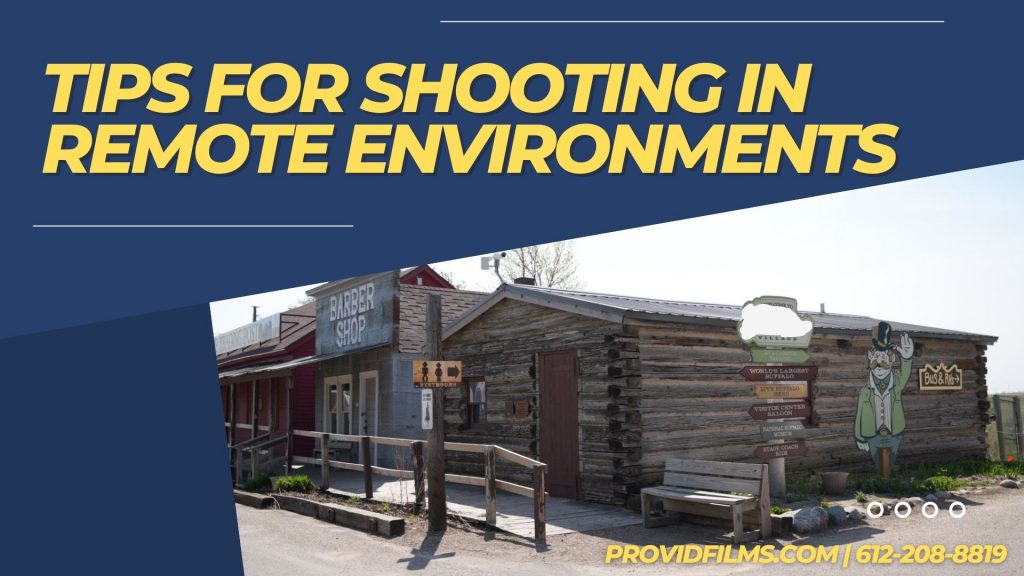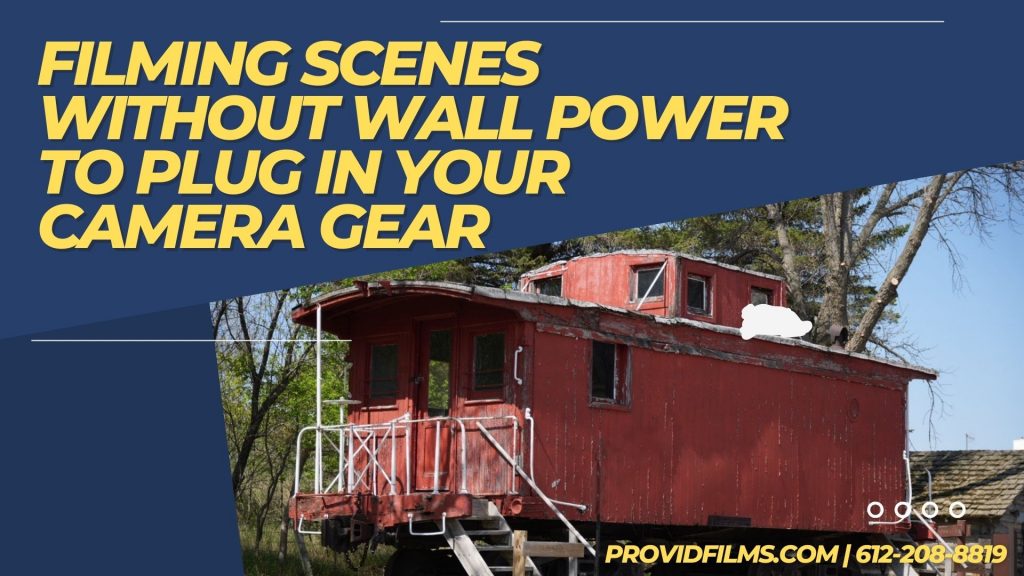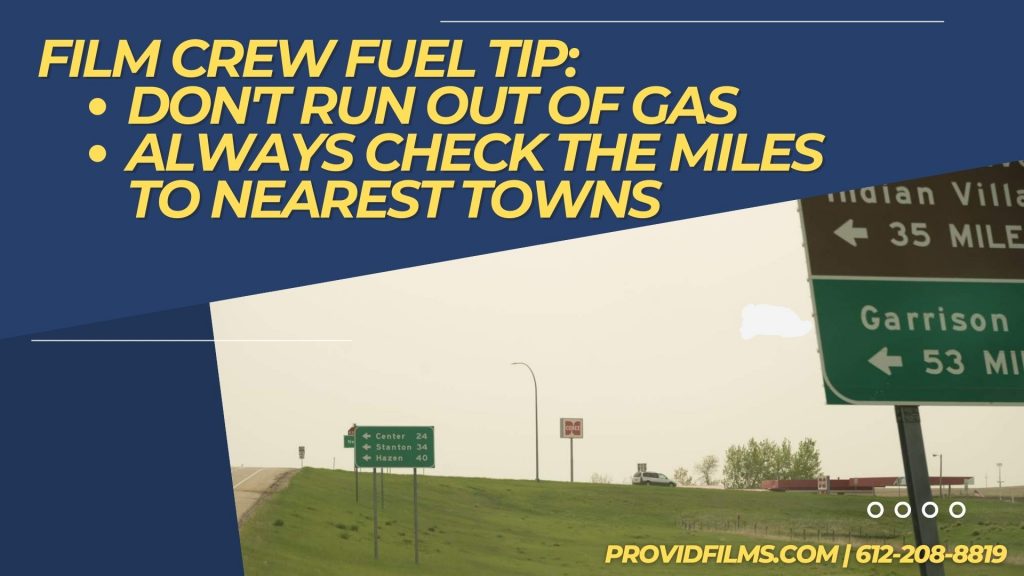Tips for video production / Filming in Remote Environments
Tips for Video Shoots in Off-Grid / Remote Environments
This summer we had the opportunity to film for a week “off grid” all day.
This extraordinary journey presented us with a distinctive array of challenges, especially as we operated in potentially remote wilderness locations with limited access to power sources.
For those of you who possess prior experience in shooting within such remote environments or are contemplating projects in even more isolated and off-grid locales, we believe you’ll find immense value in the advice and insights we’ve gathered on optimizing this adventurous endeavor.

Here are some particular facets that initially piqued our curiosity:
1. How to keep camera gear powered offgrid / Power Management: How can we optimize power usage for camera gear in remote, off-grid locations to ensure equipment remains charged and operational throughout our expedition?
2. What video gear is best offgrid / Equipment Selection: Are there specific camera, audio, or lighting equipment recommendations that excel in remote environments, offering reliability and durability during challenging conditions?
3. How do you keep your video production gear safe offgrid / Protection and Care: What strategies can be employed to safeguard our video production gear against elements like dust, humidity, and potential rain, while still maintaining quick accessibility for capturing crucial shots?
4. What are best practices for offgrid file management / Data Management: In the absence of reliable connectivity, what are the best practices for efficient data storage and backup management to prevent the loss of valuable footage?
5. How do you light video scenes in the wilderness / Lighting Challenges: How can creative solutions be harnessed to tackle lighting challenges encountered in the wilderness, particularly during low-light scenarios or nighttime shots?
6. What did I learn about filming in the wilderness / Storytelling: What valuable insights did we gain from filming in the wilderness, focusing on storytelling and capturing the essence of the client’s work amidst the natural backdrop?

Main topics to consider shooting in remote environments.
Topic 1: Power Management without wall power
Shooting “off grid” for a week presents an exciting challenge in power management. To efficiently utilize the limited power available, consider these strategies:
- Prioritize essential equipment for charging, such as cameras, drones, and laptops.
- Use power-efficient settings on your devices to extend battery life.
- Plan shooting schedules to coincide with peak sunlight hours for solar charging.
- Carry spare batteries and large lithium battery packs to ensure uninterrupted operation.
- Invest in energy-efficient LED lighting for extended usage without draining power.
Topic 2: Equipment Selection for remote location filming
Selecting the right equipment is crucial for remote filming success. Consider these equipment recommendations:
- Opt for weather-sealed cameras and lenses to protect against environmental conditions.
- Choose lightweight, compact camera rigs for ease of transportation and maneuverability.
- Invest in a robust tripod to stabilize shots, even in uneven terrain.
- Use shotgun microphones with windshields to capture clear audio amidst outdoor noise.
- Consider using action cameras or drones for capturing unique perspectives in challenging environments.
Topic 3: Protection and Care from weather
Protecting your camera equipment from the elements is essential for long-lasting performance. Here’s how to strike a balance between protection and accessibility:
- Use weather-resistant camera bags or cases to shield equipment from dust and humidity.
- Keep silica gel packets in your camera bag to absorb moisture and prevent condensation.
- Utilize lens hoods and filters to prevent dirt and debris from directly contacting the lens.
- Keep a cleaning kit handy for quick dust removal and lens cleaning.
- Use lens and camera covers when not shooting to shield equipment from sudden weather changes.
Topic 4: Data Management for backcountry filmmaking
Managing data storage and backups without consistent connectivity requires careful planning. Here’s how to safeguard your footage:
- Carry multiple high-capacity memory cards to avoid running out of storage.
- Use portable hard drives or SSDs for immediate data backup after shooting sessions.
- Organize your footage by labeling folders and files for easy retrieval later.
- Utilize cloud storage solutions when connectivity is available to offload backups.
- Prioritize data security by encrypting backup drives and using password protection.
Topic 5: Lighting Challenges for filming in the country
Overcoming lighting challenges in wilderness settings involves creativity and adaptability:
- Embrace natural light during the golden hours for soft, warm tones.
- Use diffusers or reflectors to control harsh sunlight and create even lighting.
- Experiment with portable LED lights or small strobes for controlled lighting setups.
- Capture the ambiance of low-light situations with wider apertures and slower shutter speeds.
- Emphasize the beauty of the night sky by using long exposure techniques for night shots.
Topic 6: Storytelling Tips to Shooting in Remote Environments
Capturing the essence of the wilderness and your client’s work through storytelling requires a strategic approach:
- Research your client’s mission, goals, and projects to align your shots with their narrative.
- Focus on capturing candid moments and genuine interactions to convey authenticity.
- Utilize wide shots to showcase the environment’s grandeur and close-ups for impactful details.
- Incorporate interviews with subjects to weave personal stories into your visual narrative.
- Prioritize shots that highlight the synergy between the wilderness and your client’s initiatives.

BONUS Film Crew Fuel Tip: Don’t run out of fuel
Fueling Success: A Vital Film Crew Tip
In the world of film production, ensuring your vehicles never run out of fuel is paramount for a seamless operation. Here are some critical pointers to keep your crew on the move:
1. Strategize Gas Stops:
Before embarking on your cinematic journey, map out gas station locations along your route and near your destination. Having a strategic refueling plan in place ensures you have multiple options should the need arise.
2. Monitor Fuel Levels:
Vigilance is key when it comes to fuel management. Keep a close watch on your vehicle’s fuel gauge, especially during extended shoots or while traveling between locations. Our crew members are encouraged to never let their tanks dip below half full when covering substantial distances. Even better, make it a daily ritual to fill up if there’s any inkling of potential fuel issues.
3. Plan Wisely:
Predicting your fuel needs is part science and part art. Consider factors such as distance, travel time, and the fuel consumption of equipment. Always build in a buffer and prepare for extra pit stops if the situation warrants.
4. Top Up Whenever Possible:
Opportunities to refuel can arise unexpectedly. Whenever there’s a break in the action or you’re within reach of a gas station, seize the moment to top up the tank. Even if your tank isn’t running on empty, a quick fill-up can forestall future emergencies.
5. Harness Technology:
In this digital age, fuel management has gone high-tech. Leverage mobile apps that provide real-time information on nearby gas stations and fuel prices. These handy apps help you pinpoint the closest refueling spot and snag the best deals on fuel.
6. Always Be Prepared:
Filming in remote regions demands an extra layer of preparedness. Consider carrying spare fuel in approved containers, securely stored and compliant with transportation regulations. When the nearest gas station is miles away, having backup fuel can be a game-changer.
7. Foster Communication:
Open lines of communication are vital within your crew. Encourage team members to keep an eye on the fuel situation. If someone notices the fuel level dipping lower than expected, prompt communication can help resolve the issue swiftly.
And let’s not forget the generators! If your production relies on gas generators, ensure you have gas cans safely secured and ready for action. A well-prepared crew is a productive crew, and with these fuel management strategies in place, you’ll be firing on all cylinders, ready to capture cinematic magic. 🎬🚗💨
Fuel for generators is also something to consider if using gas generators. Do you have gas cans safely secured and ready to go?

BONUS Film Crew Tip: Don’t get lost unless you are on an enchanted highway
Pro Crew Tip: Save Getting Lost for Enchanted Highways Only
Navigating the winding roads and remote locations of your countryside shoot requires some strategic planning. Here’s how we, as a film crew, ensure we stay on track:
-
Advance Reconnaissance: Before the adventure begins, we immerse ourselves in the shooting locations. We study maps, note GPS coordinates, and learn about local landmarks to build a mental roadmap.
-
Tech-Forward: In this digital age, we rely on navigation apps like Google Maps or Waze for real-time directions, traffic intel, and estimated travel times. We make sure everyone on our crew has these apps at their fingertips.
-
Offline Backup: We’re not immune to dead zones. For those remote areas with spotty reception, we download offline maps in advance. These maps provide a lifeline of basic navigation even without an internet connection.
-
Navigator Designation: On our team, we have a designated navigator. This point person handles inputting directions and provides live updates to the driver, keeping everyone on the same cinematic page.
-
Communication Hub: Staying connected is key. We use walkie-talkies, group messaging apps, or two-way radios to communicate effortlessly, keeping each other informed about any unexpected plot twists.
-
Caravan Mode: If our crew involves multiple vehicles, we opt for a caravan approach. The lead vehicle plays navigator, following a well-plotted course, while the others follow in line, ensuring no one takes a detour to a different movie.
-
GPS Gadgets: For precision in diverse conditions, we consider dedicated GPS devices. These gadgets are reliable co-stars, especially when the script calls for challenging terrains.
-
Paper Maps in the Toolkit: Technology can have its takes, so we always have physical maps of the area on standby. When the digital stars don’t align, we revert to old-school navigation.
-
Traffic Rehearsal: Prior to hitting the open road, we rehearse the script by checking for potential roadblocks, alternate routes, or congestion that could hijack our travel plans.
-
Landmark Lingo: To help us frame our scenes, we identify distinct landmarks or standout features near our locations. These serve as our on-location cue cards, ensuring we’re on the right cinematic track.
-
Local Intel: We love connecting with locals or the scouting team. Their behind-the-scenes insights into shortcuts, secret paths, and local traffic patterns are golden nuggets of wisdom.
-
Pre-Travel Script Meeting: Before shouting “action” on the road, we gather for a pre-travel meeting. Here, we review the route, discuss potential plot twists, and ensure our entire cast and crew are ready to roll.
-
Stay in Character: If we find ourselves in an unexpected plot twist or temporarily lost, we don’t go off-script. We pull over safely, double-check our maps or navigation apps, and refocus on our cinematic quest.
-
Emergency Scene Cards: We never leave the trailer without a list of emergency contacts for each location. It includes the local authorities and our production coordinator, ready to swoop in if we need a plot-saving twist.
With these tips from our crew’s playbook, you’ll navigate the twists and turns of your off-grid video project across the countryside with confidence, ensuring your filming experience is a smooth, cinematic success. Onward to capturing breathtaking scenes! 🎥🌄

I trust these valuable insights will serve as your guiding stars during your off-grid filming odyssey. As you embark on this thrilling adventure in remote locations, seize each challenge as an opportunity to craft remarkable cinematic narratives. Keep the flames of adaptability and creativity burning brightly throughout your journey.
Embracing the Wild Terrain
Venturing into off-grid territories offers a unique canvas for storytelling. The untouched landscapes, the unfiltered sounds, and the uncharted paths all beckon for exploration. Let these environments become your co-authors in crafting unforgettable visual tales.
The Power of Adaptability
In the heart of the wilderness, adaptability is your most valuable tool. Whether it’s an unexpected weather shift, an impromptu storyline tweak, or a gear hiccup, being nimble and quick on your feet can turn challenges into serendipitous moments of brilliance.
Creativity Beyond Bounds
Remote locations foster boundless creativity. The absence of familiar settings encourages you to think outside the frame. Embrace the unexpected, and let the surroundings infuse your work with a fresh perspective that sets it apart.
A Cinematic Offer for Off-Grid Projects
Should you find yourself in need of a seasoned crew and top-tier gear for an off-grid project in the USA, don’t hesitate to reach out. We’re passionate about these kinds of cinematic adventures and would relish the opportunity to collaborate on your next project.
Connect with Us
We invite you to connect with us and delve deeper into the possibilities that await your off-grid filming endeavor. Share your vision, your challenges, and your dreams with us, and together, we can create cinematic experiences that resonate deeply with audiences far and wide.
In the vast wilderness of off-grid filmmaking, let your creativity flow like a wild river, and may every frame tell a compelling story. We look forward to being part of your next cinematic masterpiece! 🎬🌿
Given our gear and crew, if you have a project you need to film off-grid in the USA, reach out to connect. We’d love to chat more.
Filming offgrid and in the wilderness takes proper preparation, and can be an adventure everyone deserves to experience.






Check pricing, availability & get questions answered!
Fill out the form below or just call 612-208-8819